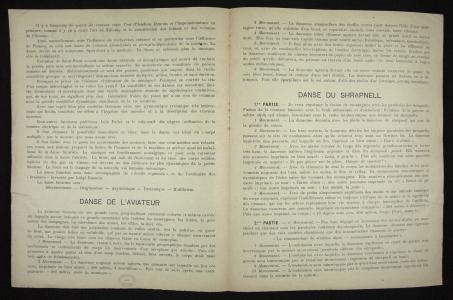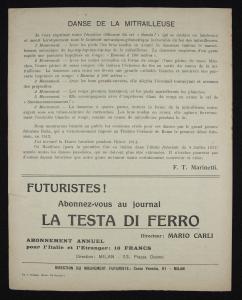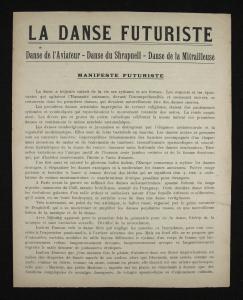

La danse futuriste : danse de l,aviateur, danse du shrapnell, danse de la mitrailleuse : manifeste futuriste
1. The complaint, and the consolation; or, Night thoughts
2. The Fables of Æesop, and others / With designs on wood, by Thomas Bewick
5. News from nowhere: or, An epoch of rest, being some chapters from Utopian romance
6. The nature of Gothic, a chapter of the stones of Venice
7. Daphnis and Chloe: a most sweet abd pleasant pastoral romance for young ladies
8. The Sphinx
10. Credo
14. Bible.Old Testament. Song of Solomon.
16. Kem byt’? / V. Maiï¸ a︡kovskiĭ ; ris. N. Shifrin.
17. The ghost in the underblows
19. Bateau ivre
UCLA Call Number: Sontag NX456.5.F8 M27 1917

La danse futuriste : danse de l,aviateur, danse du shrapnell, danse de la mitrailleuse : manifeste futuriste

La danse futuriste : danse de l,aviateur, danse du shrapnell, danse de la mitrailleuse : manifeste futuriste

La danse futuriste : danse de l,aviateur, danse du shrapnell, danse de la mitrailleuse : manifeste futuriste
Contributor:
Contribution date:
-->
Full title
Creator: Marinetti, F. T.
Publisher: Direction du Mouvement Futuriste
Publication Place: Milan
Date of Publication: 1917
Dimensions 35 cm
Physical Description:
La danse futuriste is printed on a single folded sheet of very thin paper. It features no covers, bindings, endpapers, decorations, or illustrations. The entirety of the text is printed in black ink on light–colored paper. Modern typefaces are used throughout the entire document, and variance in type is present only in the title and subtitle portions. A bold type with extremely thin serifs are used for the main title, which runs across the top edge of the front page. Subtitles appear in different, smaller types underneath. Both title and subtitles are emphasized with thin horizontal lines that run from one margin of the page to the other. A sans serif type is used for subheadings within the text.
Provenance:
This item is part of the Susan Sontag Collection at the Charles E. Young Research Library at UCLA and is “made possible by a gift from an anonymous donor.”
Condition:
The item shows browning on the edges and overall discoloration from age, but is in overall good condition with no tears or stains. Gentle handling is required due to the thinness and delicacy of the materials.
Additional Info:Interpretation:
In 1909, Filippo Tommaso Marinetti issused his first manifesto, “The Founding and Manifesto of Futurism,” on the first page of the French newspaper Le Figaro. Confident in the triumph of modern technological developments and the dynamism of post–industrial urban life, the Futurists celebrated the ideas of speed, violence, motion, fragmentation, and vitality of youth, while rejecting the stagnancy of the past that was embodied in established artistic, political, and cultural systems. Futurism was also highly programmatic and nationalistic, actively supporting Italy’s entrance into war to reclaim land under Austrian rule. In order to promote their principles and agendas throughout Italy and beyond, Futurists released a torrent of manifestos on subjects as varied as painting, cinema, music, clothing, architecture, theater, and cooking.
La danse futuriste, or the “Manifesto of the Futurist Dance”, was published on July 8, 1917. The political and artistic scene was a whirlwind of activity at that time, with World War I in full swing and the Russian Revolution breaking out in the early months of that year. As a result, many areas of production were impacted by shortages in supplies, not least the publishing industry. [Footnote 1] At the same time, various artistic movements were developing concurrently and overlapping with one another, as artists sought to come to terms with the changes happening around them. Expressionists, Fauvists, and Cubists explored new modes of expression and perception, and Suprematism and Dada were in an early state of percolation. The year 1917 would also come to mark the beginning of Constructivism in Russia, and De Stijl in the Netherlands. These artists would come to be known as the “avant–garde,” as they continually pushed the boundaries of what was previously known and accepted to be the norm.
The aims of early 20th century avant–garde artists’ involvement in the production of print materials were in extreme contrast to William Morris’s notion of the “Ideal Book” and the endeavors of his own and other private presses to imbue the book with artistic preciosity. Instead, the artists of Futurism and other avant–garde movements aimed to escape the fetishization of the book as an artistic object by aligning themselves with modern technologies of mass communication that were primarily employed for the circulation of news and advertising. Eluding the private press studio, they explored print media outside of the canonical book form, using periodicals, ephemera, posters, and other inexpensive formats as their means of production. Artists like Marinetti found the value of the manifesto not in the individual artistry of the object, but rather in its power to quickly and cheaply communicate a group ethos to a wide audience. The manifesto was especially unique in its lack of a firm code regarding its physical actualization, [Footnote 2] appearing independently or in established periodicals such as Le Figaro. The flexibility of avant–garde artists in their attitude toward form speaks to their aim of dismantling all traditionally accepted structures, including the tyranny of the sequential codex book.
La danse futuriste lacks illustration or decorative elements, obviating the need for the time–consuming processes of image design and printing, which often required separate techniques or machinery. Instead, modern typefaces are employed in its title as the main source of its visual appeal. This lack of investment in decorative elements does not, however, indicate that the manifesto is any less self–aware than the private press book, but rather the opposite; the rejection of these elements boldly brings into question their assumed value.
1. Johanna Drucker, The Century of Artist Books, New York: Granary Books.
2. Stephen Bury, ed. Breaking the Rules: The Printed Face of the European Avant Garde 1900-1937. London: The British Library. 2007
In La danse futuriste, Marinetti observes and criticizes the sensual and emotive tendencies of contemporary dance in Italy, calling instead for a “pure geometry of the dance, free of mimicry and without sexual stimulation.” [Footnote 1] He calls for human dance to imitate machines, and to “fuse with the divine machines of speed and war.[Footnote 2] He then presents three Futurist dances inspired by “the three mechanisms of war: shrapnel, the machine gun, and the airplane.” [Footnote 3]
1. F. T. Marinetti, “Manifesto of the Futurist Dance,” in R. W. Flint, ed., Marinetti: Selected Writings, New York: Farrar, Straus and Giroux. 1971.
2. Ibid.
3. Ibid.